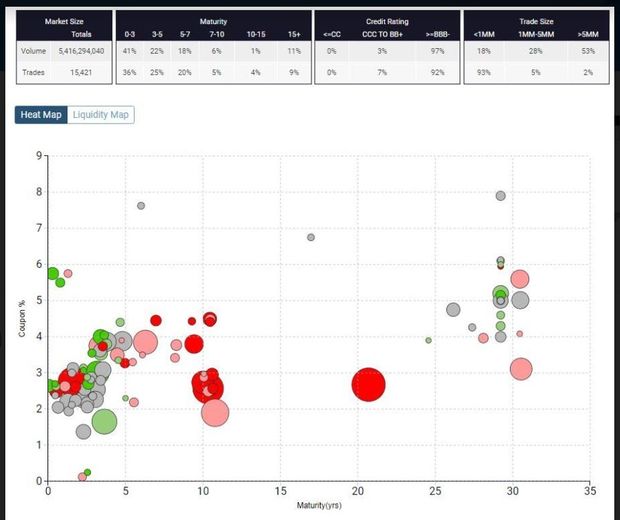
Bank of America Tower in New York
AFP/Getty Images
Third-quarter corporate earnings kicked off this week with debt investors taking a more bullish view on big banks over the next five years.
That’s at least the signal coming from the bond market, where investors have been busy snapping up shorter-term bank debt on the view that major lenders can benefit as the economy heals from the worst of the coronavirus crisis.
This chart shows clusters of trades concentrated in shorter-term bank debt since Monday, when Wall Street’s biggest lenders kicked off corporate earnings in earnest.

Betting on short-term debt
BondCliq
Green bubbles signify trading in big-bank bonds where spreads have tightened, often due to higher demand or the perception that an asset poses less of a default risk. Red bubbles point to more risk-averse trading. Spreads are the level of compensation investors earn on a bond above a risk-free benchmark, often U.S. Treasurys TY00, -0.01%.
The more bullish tone for bank debt comes as the industry enters the homestretch of a punishing year, with banking shares still down about 30% on the year to date, even as a handful of technology companies have helped major U.S. stock indexes trade near record territory.
The S&P 500 index SPX, -0.15%, the Dow Jones Industrial Average DJIA, -0.06% and Nasdaq Composite Index COMP, -0.46% each closed Thursday within 4% of their all-time records, according to Dow Jones Market Data.
However, Goldman Sachs analysts think the time might be ripe for downtrodden sectors like banks to shine.
Read: Move over, tech. It’s finally value’s turn, Goldman says
Back in the bond world, debt from Bank of America BAC, +2.24% was the most actively traded on Thursday from the financial sector, accounting for $703.2 million worth of trades and 7.1% of the day’s overall action, according to BondCliQ, a corporate-debt tracking platform.
Drilling down, Bank of America’s 2.5% coupon bonds due in two years were the most active from its five-year maturity range, even as spreads on the 2022s narrowed by about 6 basis points, according to BondCliQ.
In other words, investors were buyers, even though the bonds paid less.
In other debt trading Thursday, Morgan Stanley MS, +1.34% bonds were the second-most active among financials at a 5.3% share, when looking only at a five-year maturity horizon, followed by Citigroup C, +1.34% at 4.4% and JPMorgan Chase & Co. JPM, +1.49% at 3.9%, per BondCliQ.
Equity investors also took a more positive view on Bank of America on Thursday as shares rose 2.2%, a reversal from a day ago when it reported better-than expected profit for the third quarter, but revenue that fell more than forecast. Executives provided an upbeat outlook for net interest income next year.
“There isn’t much to complain about in 3Q20,” wrote Jesse Rosenthal’s team at CreditSights, of Bank of America’s results, other than “softer trading perhaps, but that may well be risk positioning.”
However, the CreditSights team did point to “management’s relatively more bullish macro commentary” that set it apart from its peers, and warned that “those rosier expectations could boomerang if the recovery falters.”










Add Comment